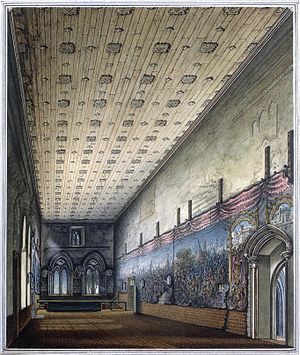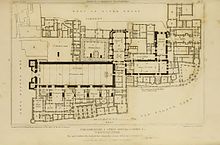Painted Chamber

The Painted Chamber was part of the medieval Palace of Westminster. It was gutted by fire in 1834, and has been described as "perhaps the greatest artistic treasure lost in the fire".[1] The room was re-roofed and re-furnished to be used temporarily by the House of Lords until 1847, and it was demolished in 1851.
The chamber was built by

The chamber was originally named the King's Chamber. It adjoined a new Queen's Chamber to the south, later used for meetings of the House of Lords until it moved to the Lesser Hall or White Chamber in 1801; the Queen's Chamber was demolished along with other buildings in 1823.[3] The King's Chamber came to be known as the Painted Chamber after its decorative wall paintings, of Virtues and Vices, and Bible figures. The brightly coloured paintings took 60 years to complete, starting in 1226. The original paintings were repaired in 1263 after they were damaged by fire, and again in 1267 after they were damaged by a mob that invaded the palace. The murals were supplemented by paintings commissioned by subsequent monarchs.
The Painted Chamber was later neglected, and the walls were whitewashed, papered and covered by tapestries as depicted in the watercolour of
The Painted Chamber survived largely intact for over 600 years. In the later 13th century, some of the early
The room was also used for other state purposes. At the
The chamber was gutted in the devastating fire in 1834, but the thick medieval walls survived. Wood salvaged from the Painted Chamber was used to make souvenirs. The room was re-roofed and re-furnished to be used temporarily by the House of Lords for the State Opening of Parliament on 23 February 1835. It was used by the House of Lords until 1847, and finally demolished in 1851.
References
- ^ The Fire of 1834 and the Old Palace of Westminster, parliament.uk
- ^ Henry III and the Painted Chamber, parliament.uk
- ^ The Day Parliament Burned Down, Caroline Shenton, p.9-10
- ^ Panel Paintings from the Palace of Westminster, London, British Museum
- ^ The Day Parliament Burned Down, Caroline Shenton, p.200-203
- ^ The Painted Chamber, All Change at the Palace of Westminster, BBC History, 2 February 2005. The many conferences between Commons and Lords that resulted in the Petition of Right were held in the Painted Chamber. E.g. Journal of the House of Lords: Volume 3, 1620-1628 (London, 1767-1830), for 4/7/1728, the date of the first such conference, states that Commons asked for a conference on "the Liberty of the Subject" and "some ancient Fundamental Liberties of the Kingdom.Answered: The Lords will give them a Meeting, by a Committee of both Houses, at Three this Afternoon, in the Painted Chamber."
- ^ Paul Binski, The Painted Chamber at Westminster. London: Society of Antiquaries, 1986. (Occasional Paper, n.s. 9.)
- ^ Walter Thornbury, 'The royal palace of Westminster', in Old and New London: Volume 3 (London, 1878), pp. 491-502
- ^ Brayley, Edward Wedlake; Britton, John (1836). The History of the Ancient Palace and Late Houses of Parliament at Westminster, Etc.
External links
- Oak ceiling ornament from Painted Chamber, Sir John Soane's Museum
- The Painted Chamber and St. Stephen's Chapel after the Fire, 1834, parliament.uk
- Interior of Painted Chamber after the Fire 1834, parliament.uk
